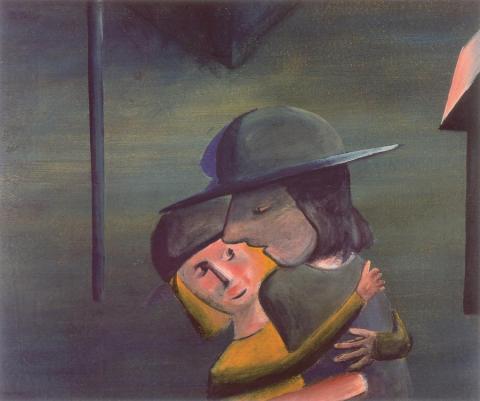TWO SCHOOLGIRLS, 1953
CHARLES BLACKMAN
oil on board
63.5 x 76.0 cm
signed and dated lower right: 3 July 1953 Blackman
Private collection
Savill Galleries, Sydney (label attached verso)
Private collection, Sydney
Charles Blackman's acclaimed schoolgirl series of paintings and drawings had its public debut in Melbourne in 1953, the same year in which Two Schoolgirls was painted. Exhibited at the Peter Bray Gallery, it was Blackman's first solo show, the source of Blackman's inspiration, Shaw Neilson's lines from Schoolgirls Hastening, appearing in the catalogue:
Fear it has faded in the night.
The bells all peal the hour of nine.
Schoolgirls hastening through the light
Touch the unknowable divine.
Since those many years ago, these young faces have found a place among the iconic works of Australian art. Celebrated, they are legendary for their understanding of children through Blackman's ability to enter their minds and imagination, then paint what he sees. For he sees the world through the eyes of a child, and feels her fears, especially isolation and loneliness, so movingly expressed in Two Schoolgirls. They are alone in an environment that threatens through its darkness, empty of protection, yet full of the unknown. Even the two buildings project rejection by their angularity, closed to their needs. They embrace for protection and mutual support, their inner fears stamped in face and profile. The emptiness of the streets is palpable, voluminous of atmosphere in which stalk the latch-key kids' ongoing nightmares. Yet, there is a lyricism in the colours, which tell of happier dreams, of blue as a sanctuary, the colour long associated with goodness and the maternal. It is through these means of form and colour that Blackman gives visibility to emotions and re-introduces the viewer to his or her childhood with an innocence that is disarmingly irresistible.
Blackman's schoolgirl paintings are so telling because he drew deeply on personal experience for their creation. 'The Schoolgirl pictures had a lot to do with fear, I think. A lot to do with my isolation as a person and my quite paranoid fears of loneliness and stuff like that; and indeed you could almost say why I painted them.'1 From the beginning, the schoolgirl paintings and drawings were recognised by the perceptive as something special. Art critic for the Melbourne Herald, Alan McCulloch, acknowledged their 'undeniable power and artistry'. 'In Blackman's hands', he continued with presience, 'Neilson's schoolgirl becomes a creature of endless aesthetic possibilities.'2 And so it proved to be, as seen in this and other paintings - Prone Figure, 1953 (Heide Museum of Modern Art, Melbourne), Floating Schoolgirl, 1954 (National Gallery of Australia, Canberra), and The Cigarette Shop (Running Home), 1954 (National Gallery of Victoria, Melbourne).
1. Blackman, quoted in Shapcott, T., The Art of Charles Blackman, Andre Deutsch Ltd, London, 1989, p. 11
2. McCulloch, A.,'Quantity " and Quality', Herald, Melbourne, 12 May 1953, p. 10
DAVID THOMAS
